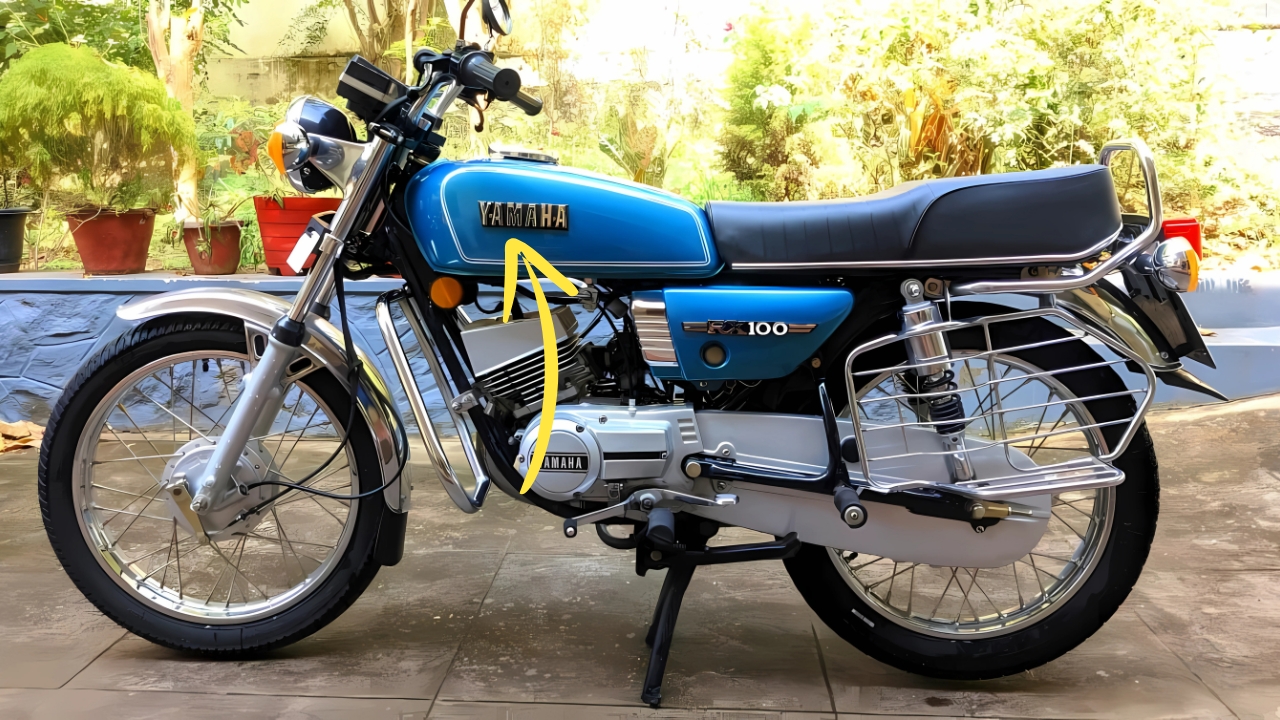Yamaha RX100: The Yamaha RX100 stands as one of the most iconic motorcycles in Indian automotive history, having transcended its status as a mere mode of transportation to become a cultural phenomenon that continues to inspire enthusiasts decades after its production ceased.
Introduced in 1985 through the collaboration between Yamaha Motor Company and Escorts Group, this lightweight two-stroke motorcycle established new benchmarks for performance, reliability, and value that resonated profoundly with the Indian market during a transformative period in the nation’s mobility landscape.
Yamaha RX100: Engineering and Technical Composition
The RX100’s engineering philosophy embraced elegant simplicity, featuring a 98cc two-stroke, air-cooled single-cylinder engine producing approximately 11 horsepower at 7,500 RPM and 10.39 Nm of torque at 6,500 RPM.
While these figures appear modest by contemporary standards, the motorcycle’s lightweight construction—approximately 103 kg—resulted in a power-to-weight ratio that delivered remarkable acceleration and responsiveness.
The claimed top speed of 100 km/h represented exceptional performance in its category during the mid-1980s.
The engine incorporated Yamaha’s proven reed valve induction system, enhancing low-end torque and throttle response while maintaining strong mid-range power delivery.
The five-speed constant mesh transmission featured a well-calibrated gear ratio spread that balanced acceleration with cruising capability.
The straightforward yet effective wet multiplate clutch provided reliable power transfer with reasonable maintenance requirements.
The chassis utilized a single downtube frame with a pressed steel backbone, striking an effective balance between structural rigidity and manufacturing efficiency.
Suspension duties were handled by telescopic front forks with 130mm travel and dual rear shock absorbers offering 110mm travel, providing adequate compliance for varied road conditions while maintaining handling precision.
The 18-inch wire-spoke wheels contributed to both aesthetic appeal and practical durability on Indian roads.
Braking systems featured a 130mm drum mechanism at both ends—a configuration that, while limited by modern standards, provided adequate stopping power given the motorcycle’s weight and performance parameters of its era.
The fuel tank capacity of 10.5 liters enabled a reasonable operating range despite the relatively thirsty nature of two-stroke engines.
Design Language and Aesthetic Appeal
The RX100’s design language embraced minimalist functionality with subtle sporting cues that created timeless visual appeal.
The teardrop-shaped fuel tank featured distinctive chromed side panels bearing the model designation, creating immediate brand recognition.
The slender proportions and carefully balanced visual mass distribution created an impression of lightness that accurately reflected the motorcycle’s dynamic character.
The single-piece seat offered reasonable comfort while maintaining a clean silhouette, sloping gently upward toward the rear.
Chrome accents on the mudguards, exhaust system, and instrumentation housing provided visual highlights against the predominantly painted surfaces, typically finished in Yamaha’s signature black, red, or blue colorways.
The instrumentation remained elegantly spartan, featuring an analog speedometer with integrated neutral and turn signal indicators—providing essential information without unnecessary complexity.
The slightly raised handlebar position created a natural riding posture suitable for both urban commuting and occasional longer journeys.
Cultural Impact and Market Position
The RX100’s introduction coincided with a pivotal period in India’s economic trajectory, as liberalization policies began gradually opening the market to international products and increasing consumer aspirations.
The motorcycle offered an appealing combination of Japanese engineering precision and reasonable affordability, establishing itself as an aspirational yet attainable product for the emerging middle class.
Sales figures reflected this positioning, with production volumes reaching several hundred thousand units during its manufacturing run from 1985 to 1996.
The model became particularly popular among younger riders attracted by its performance capabilities and distinctive exhaust note—a characteristic two-stroke sound that became instantly recognizable on Indian streets.
Beyond quantitative success, the RX100 achieved remarkable cultural resonance. The motorcycle frequently appeared in Indian cinema, further cementing its iconic status.
Its reputation for brisk acceleration earned it a special place in motorcycle folklore, with the phrase “Yamaha tezi” (Yamaha speed) entering common parlance to describe anything notably fast.
This cultural imprint extended beyond metropolitan areas into smaller towns and rural regions, creating a nationwide recognition that few consumer products have achieved.
Legacy and Continued Relevance
Though production ceased in 1996—primarily due to evolving emission standards that disadvantaged two-stroke technology—the RX100’s influence continued expanding through subsequent decades.
The model established enduring engineering principles and performance expectations that informed later Yamaha products, while creating a loyal enthusiast community that maintains and restores surviving examples.
The motorcycle’s enduring appeal manifests in several tangible ways. Well-preserved or professionally restored examples command remarkable prices in the vintage motorcycle market, often selling for several times their original retail value.
Specialized maintenance workshops catering specifically to RX100 owners have sustained viable business models decades after production ended. Enthusiast gatherings and organized rides dedicated to the model occur regularly across the country.
Perhaps most tellingly, persistent market rumors about a potential modern reinterpretation of the RX100 continue circulating despite Yamaha offering no official confirmation.
This speculation demonstrates the model’s continued resonance with both original owners now in their 50s and 60s, and younger enthusiasts who never experienced the motorcycle during its production run but recognize its significance.
The Riding Experience
The RX100’s lasting impression stems largely from its distinctive riding character. The two-stroke engine delivered power with an immediacy rarely found in four-stroke alternatives, creating an engaging experience even at modest speeds.
The lightweight chassis offered nimble handling that inspired confidence in urban environments while remaining stable during highway travel.
The mechanical symphony of the two-stroke powerplant—from the distinctive intake sound to the characteristic exhaust note—created multisensory engagement that modern motorcycles, with their emphasis on refinement and noise suppression, rarely match.
The straightforward control layout and minimal electronic intervention created a direct connection between rider inputs and vehicle response, emphasizing mechanical authenticity over technological assistance.
Yamaha RX100:
The Yamaha RX100 represents far more than a successful product in Yamaha’s historical portfolio—it stands as a cultural touchstone that helped define motorcycling aspirations for a generation of Indian riders.
Its combination of accessible performance, distinctive character, and everyday practicality created a template for motorcycling excellence that continues influencing contemporary expectations.
While environmental considerations have rendered two-stroke technology largely obsolete in current production motorcycles, the engineering principles that made the RX100 exceptional—lightweight construction, responsive handling, and engaging power delivery—remain relevant benchmarks for motorcycle development.
The model’s enduring popularity decades after production ceased demonstrates how exceptional product execution can transcend technological evolution to maintain cultural relevance across generations.
As the automotive landscape increasingly embraces electrification and autonomy, the RX100’s legacy serves as a reminder that the most memorable vehicles often succeed not through technological complexity but through the purity of the connection they establish between machine and operator—a principle that remains relevant regardless of propulsion technology.

